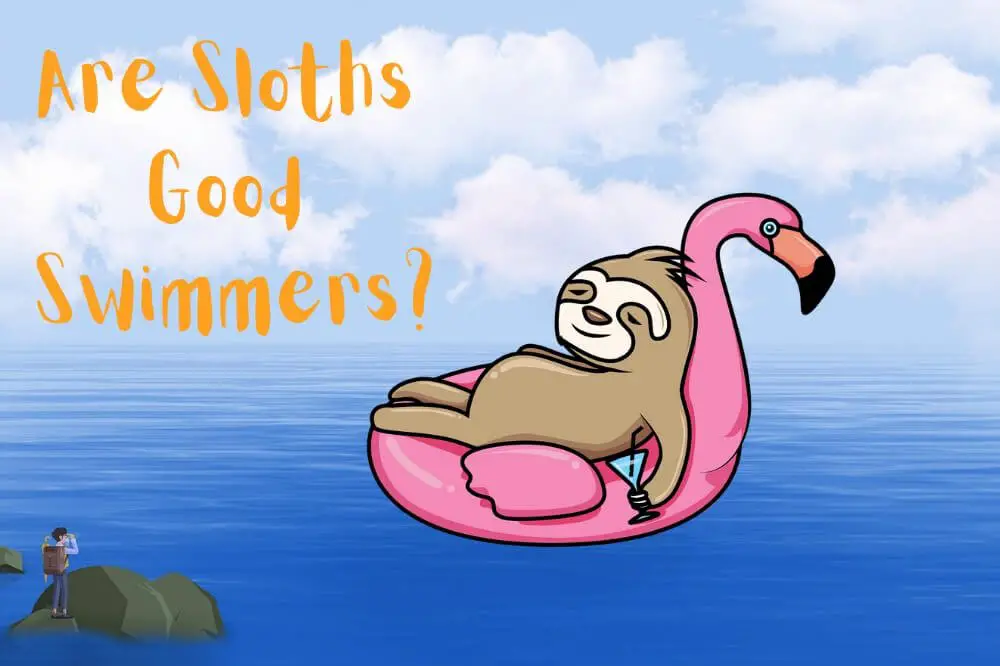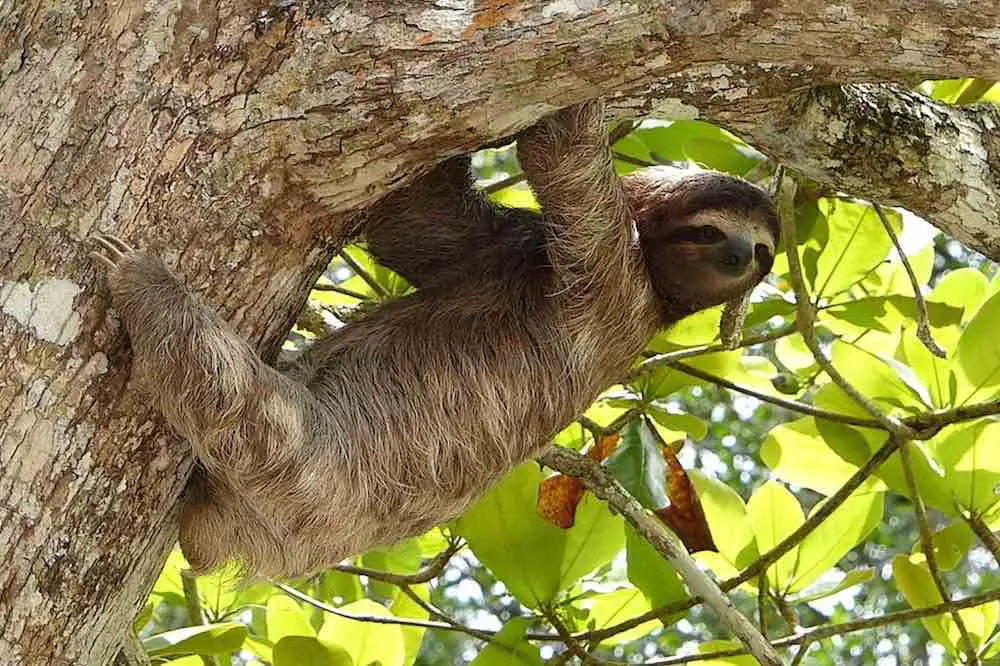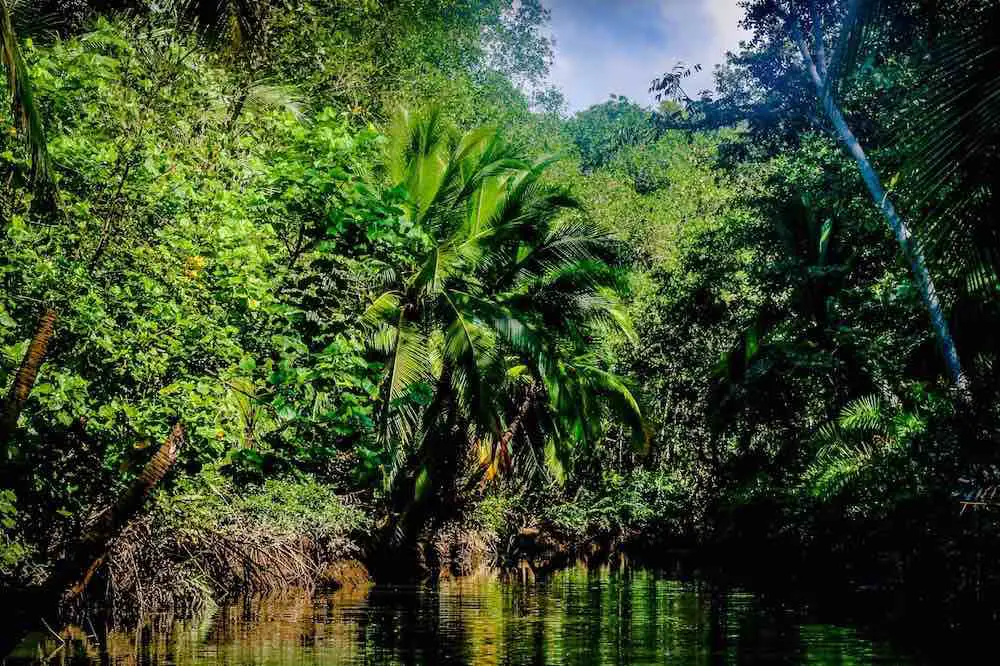
Sloths have a bit of an unfair reputation as being lazy creatures. We know they are not fast movers on land, but are sloths good swimmers?
I wanted to know the answer to this, and so had a look into the factors that could possibly help sloths to swim.
So are sloths good swimmers? Sloths are good swimmers, moving 3 times quicker than on land. They have long arms with slow-twitch fibres that are strong from hanging in trees. They can hold their breath for up to 40 minutes underwater, are buoyant due to their diet, and can keep their head above water with their flexible necks.
So then sloths are good swimmers. I’ve gone into some more detail below about why exactly they are good at this.
I’ve also provided some information about how fast they swim, why they need to swim, and one extinct sloth that was in fact an excellent swimmer. Read on to find out more!
Contents
Are Sloths Good Swimmers?
I think in general sloths have one of the worst reputations in the animal kingdom. Just think about their name for starters! If you’ve ever watched the film ‘Seven’ with Brad Pitt and Morgan Freeman, you will know that sloth is one of the deadly sins.
Probably the best or most widely known fact about sloths is how little they move right? It is true that sloths don’t move often. They live high up in the canopies of the trees in rainforests. Most are nocturnal, and even the diurnal sloths are only awake for a few hours a day.
This is not for no reason though. Sloths aren’t the best at defending themselves, and so the best way to make sure they stay alive is to stay camouflaged and fairly still. There are a number of sloth predators out there, ranging from big cats like leopards, and huge eagles such as as the harpy eagle, which will attack from the sky.
So staying very still, safe high up in the trees is actually a sloth adaptation that helps to save it’s life. In fact they stay so still, and move so little that they actually have algae growing on their fur that can make sloths look green. This actually helps to keep them camouflaged.
Now in answering the question are sloths good swimmers, we are talking generally about all of the different types of sloths. There are actually six species of sloths, and 12 subspecies. These are split across two genera, or families called the two-toed and three toed sloths.
Some are better swimmers than others, and this is not the only difference between the two-toed and three-toed sloths!
In general, across all of the species of sloths, we can say that yes that are good swimmers. However, this is a relative term. Relative to the fact that as tree dwellers sloths are generally pretty terrible at moving around on land.
This is because sloths are arboreal. They are tree dwellers, who spend almost all of their lives sleeping and eating in trees. Once upon a time there were a whole host of other sloths collectively known as ground sloths.
These are all extinct now, but of the extant sloth species left, two-toed sloths are the most closely related to these early ground sloths. Some of these ground sloths, one in particular, was particularly good at swimming. We will take a brief look at this later.
So let’s take a look below at some of the traits of sloths that help us to answer the question are sloths good swimmers.
Do Sloths Arms Help To Make Them Good Swimmers?
Now when we think of sloths, we don’t necessarily think of them as being blessed with a huge amount of strength. Watch one of them moving around, and this doesn’t appear to be their strong point (see what I did there)? I saw one at an animal refuge in Mexico a few years back, and let’s just say it didn’t do much!

Now I’m not talking about the kind of strength required to be able to attack or defend. Sloths aren’t dangerous to humans, or any other animals really as long as they are left alone.
They do, however, spend a lot of time (as in most of the time) hanging around in trees. They also need to be able to climb up and down these trees. This does require a lot of strength in their arms. More so in these than in their legs. When they hang from trees, they do this upside down, using their arms mostly.
Probably largely due to it’s diet, the sloth actually has quite a poor muscle mass. It is roughly 30 percent less than other animals the same size as them. They don’t really fill up on proteins, as they pretty much exclusively live on leaves!
What they do have going in their favor though is how these muscles are built. They are made up of a lot of slow-twitch fibres. What this means is that they have muscles that are great endurance wise, but don’t need to take up a lot of energy. Perfect for the sloth, and perfect in helping us to answer the question are sloths good swimmers.
The strength and formation of muscles in their arms is just one of the reasons sloths make good swimmers. Sure they are slow, and not great at moving around on the ground, but when it comes to swimming, their arm strength, combined with some of the other factors below makes sloths good swimmers.
The three-toed sloths actually have longer arms than they do legs. Whilst this makes them even worse than the two-toed sloths at moving around on the ground, it does mean that their arms are even longer in proportion to the rest of them, helping to propel them faster through the water.
Are Sloths More Buoyant Due To Their Diet?
Now we talk a lot about the sloth’s diet. I’ve written a lot about sloths lately, and a large part of this is about what they eat. But does a sloths diet help us in finding the answer to the question are sloths good swimmers?
I believe the answer to this question is yes. Like I said above, sloths have a diet that consists almost entirely of leaves. Three-toed sloths are entirely herbivorous.
They will only eat the leaves from trees, and can survive entirely on these. Two-toed sloths are omnivorous, meaning that they can eat some other things too such as small insects.
Now the leaves in the rainforest are covered in toxins. This ensures that they are not eaten entirely by the creatures that live there. The sloth’s stomach is split into up to four different chambers, and each of the have bacteria that help to break down the toxins in these leaves.
Due to their diet, and extremely slow metabolism, sloths only come down from the trees to go to the toilet once every seven to ten days.
They go to the toilet at the foot of the trees they live in, which means sloths actually help the environment a lot. By the time they go to the toilet, their body is made up of about 30% waste.
The gas inside of a sloth from the amount of waste built up actually helps it to float extremely well, and is another factor that helps to make sloths good swimmers.
How Long Can Sloths Hold Their Breath?
Now we already know that sloths have an incredibly slow metabolism. It can take between 30 and 50 days for them to digest the leaves that they eat. This is why they move so slowly!

However, did you know that a sloth is capable of controlling this metabolism? This actually helps us in answering the question are sloths good swimmers. Sloths are capable of slowing their metabolism down to such a degree that they can decrease their heart rate to a third of it’s normal rate.
How does this help to make sloths good swimmers though? Well in doing this, they can actually massively increases the amount of time they can hold their breath underwater.
It is widely reported that sloths can hold their breath for up to 40 minutes! This is impressive, and definitely helps to make them good swimmers!
Does A Sloth’s Neck Help It To Swim?
Another interesting fact about sloths is that they do not posses the the same amount of cervical vertebrae as almost every other mammal on the planet. Almost all mammals, apart from sloths and manatees possess seven vertebrae.
Whilst two-toed sloths possess less than the usual seven, having five vertebrae, three-toed sloths have more. They have nine of these, which means that they can turn their heads way more than normal. Most three-toed sloths can turn their heads 270 degrees.
This is really useful for sloths when they are in the water. It allows them to easily keep their head out of the water, and constantly check for predators such as anacondas that can attack them in the water.
This helps in our answering the question are sloths good swimmers. They have several traits, such as their necks, that help to make them good swimmers.
Why Do Sloths Swim?
For a tree dwelling creature such as a sloth, the idea of swimming seems a bit wild to me! They spend all of their time hanging around in trees. So why on earth would they come down from here to go for a swim?

It’s not that they actually like to go for a swim really. Swimming for a sloth has a practical purpose to it. Now sloths might be good at hanging around, but they are certainly not good at moving around on the ground.
This is very difficult for them, and they move extremely slowly. If they want to move between different areas of the rainforest, it is actually easier for them to do this in the water than it is by walking.
You could almost describe the rivers in the rainforest as corridors connecting different areas. The sloths use these corridors to navigate between different areas, which again is much quicker for them than walking.
Another factor that gives rise to sloths needing to swim at times in the rainforest comes from the rain itself. Due to high levels of rainfall, the areas that sloths live in can often become flooded. For them to move between trees and different areas at times they will have to swim due to the increased water levels.
How Fast Can Sloths Swim?
Now we know that sloths are not quick movers on land. Their muscle definition makes it almost impossible for them to walk, and for three-toed sloths, with arms longer than legs, it’s even more difficult.

Sloths move so slowly on land that they cover about 4 metres per minute. At a push if they were in a rush, say being chased by a predator they could cover 4.5 metres per minute. This is not fast by any means, and will not save them for sure!
So how fast can they swim in comparison? Sloths can reach speeds of up to around 13 metres per minute. Not ground breaking by any stretch of the imagination, and won’t win any races for sure.
But it is much quicker than their ability to move on land, and does explain why they will choose to take to the water over moving on land any day of the week!
Is A Sloth’s Swimming Ability Inherited From Extinct Sloths?
Sloths having the ability to swim is not a new thing. Some of the now extinct ground sloths were good swimmers, and one in particular was very adept at this.
The Thalassocnus is an extinct species of semi-aquatic ground sloth from the Megatheriidae family of sloths. It is the only known actual aquatic sloth. They adapted to this over millions of years, developing a bone density that allowed them to submerge in water, and nostrils that allowed them to breathe underwater too.
Summing Up
I set out to answer the question are sloths good swimmers? I think I have shown that the answer is yes, albeit that this is all relative.
In comparison to other aquatic creatures, sloths are slow swimmers. They can reach up to speeds of around 13 metres per minute. Not fast in comparison to other water creatures, but more than three times quicker than their ability to move on land.
They have long arms with slow-twitch fibres making them ideal for swimming. They are buoyant due to their diet, and can hold their breath for up to 40 minutes underwater.
Three-toed sloths can turn their head up to 270 degrees, which helps them keep their heads above water when swimming.
I hope you have found the information in this article helpful. If you want to add anything to it, or have any questions, then please feel free to leave a comment below.

